December 31st, 2003
Ferrari Historics, 2003
By Alessandro Gerelli
Pictures copyright Alessandro Gerelli
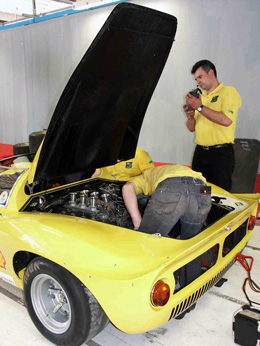
Ferrari Dino 206S: when space is not enough.(Carlos Monteverde)
|
Scroll down for photo gallery.
Since 1997, Ferrari has organized a challenge for its historic cars in Europe and USA. The challenge was extended to include Maserati in 1999.
This year the races in Europe took place at Spa-Francorchamps (Belgium), Monza (Italy), Donington (UK) and Nurburgring (Germany), with the final event in Mugello (Italy) which combined all the finals of the Ferrari and Maserati challenges and the team world championship celebration.
The cars are divided in three "grids": grid A for the single-seaters, grid B for the cars with drum brakes and grid C for disc brakes, with few adjustments to level the performances. Privately owned and in perfect racing condition, the entrants cover the period from the pre-war Alfas of Scuderia Ferrari to the sport-prototypes of the 1970s.
SPA-FRANCORCHAMPS
The first event took place at the end of April at Spa: this very old and famous circuit is located in the Ardenne forest, a hilly region near Liege.
This year the weather was not favorable, with heavy rain that made the races even more difficult. Both the grid A races witnessed the victory of the Maserati 250F of Thomas Bscher with Burkhard von Schenk second on a similar car, followed by Stefan Schollwock and Irvine Laidlow, both driving Maserati 6CMs.
Due to the bad weather, the Ferrari berlinettas were favored in the grid B race and Vincent Gaye won both the races with his 250SWB over the Maserati 300Ss of Thomas Bscher and William Binnie.
The races of the grid C were hard fought. In the rain, on Saturday, Peter Hardman won driving his Ferrari 412P with John Bosch's Ferrari 365GTB4 Comp second . Thankfully, there was no rain on Sunday and William Binnie and his Ferrari 312P was first with Peter Hardman second and Bosch third.
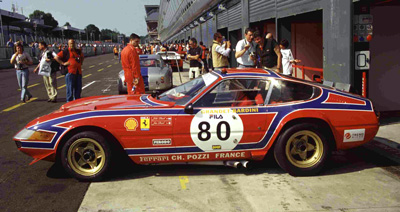
Ferrari 365 GTB4 Comp. (John Bosch)
|
MONZA
The second event of the season was at Monza at the end of May. Monza is a reference point for all the European and non-European sport cars enthusiasts, due to its long history and the important races that have taken place at this famous circuit.
The track is also open to the public during the days when there are no tests or official races: therefore everybody is allowed to enjoy driving his normal car on the circuit, dreaming to be Schumacher in his F1 Ferrari (my personal record with a Fiat 600D of 1965 is 3�30" at the astonishing average speed of 98.571 km/h).
After a year of interruption due to the huge work necessary to renew and adapt the pits to the requirements of the F1 teams, this year started again the Coppa Intereuropa for historic cars that has been combined with the Shell Historic Ferrari Maserati Challenge.
The event presented more than 100 Touring and Grand Touring cars, many formula 2 cars, more than 20 F1 machines and at least 10 F1 Ferrari cars from the 1970s to the most recent 2001 models, plus 55 cars taking part in the Historic Challenge in the usual three grids.
In the grid A race, most of the single-seaters were Maseratis ranging from the 26/B GP of 1926 to the 250 F of 1956. The winner of the two races was Bscher on a Maserati 250 F of 1956 over Laidlow (Maserati 6CM of 1937) in the first race and Von Schenk (Maserati 250 F of 1956) in the second.
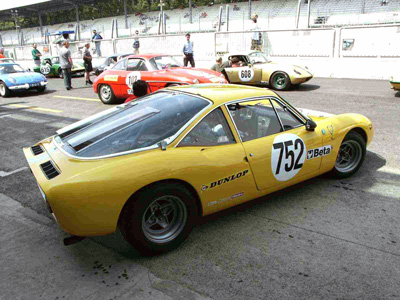
De Tomaso Vallelunga.
|
Ferrari presence was prevailing in the grid B race, with many 250 SWBs, two 250 Testa Rossas, a few 500 TRs and Mondials, but also Maseratis, including an A6GCS, 250S and 300S were very aggressive and very well prepared.
Again Bscher with his Maserati 300 S won both races, with Gaye (Ferrari 250 SWB) second and Binnie (Maserati 300 S) third.
The grid C race was for the cars with disc brakes: David Franklin with his Ferrari 712 S dominated both events, winning from Jean Guikas on a Ferrari BB LM and Peter Hardman (Ferrari 412 P) in the first race. Patrick Stieger (Ferrari 512 M) and Hardman finished second and third to Guikas in the second race.
The F1 Ferrari had two demonstration sessions: the very happy owners of these wonderful cars had the pleasure to drive their jewels on the very fast track of Monza.
Today�s cars are so sophisticated that technical assistance is provided directly by the mechanics of the Ferrari Squadra Clienti, with computers, etc. as necessary.
The lucky drivers have factory help just like Schumacher, but what a shame that now and then they are not able neither to switch the engine on nor off without the help of the mechanics!
In the paddock, I have found unusual cars like a rare De Tomaso Vallelunga, an Abarth Simca 2000, an Abarth OT 1300 and a very rare Abarth 750 spider Zagato 2nd series of 1959.
Next: Donington, Nurburgring and Mugello
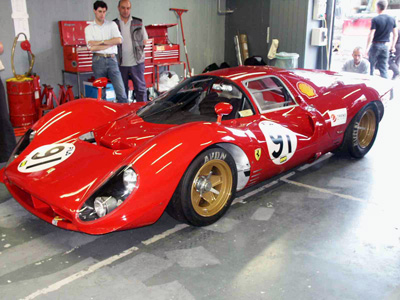 Ferrari 412P (Peter Hardman)
Ferrari 412P (Peter Hardman)
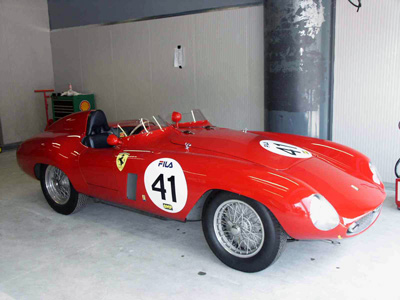 Ferrari 500 Mondial (Jan Biekens)
Ferrari 500 Mondial (Jan Biekens)
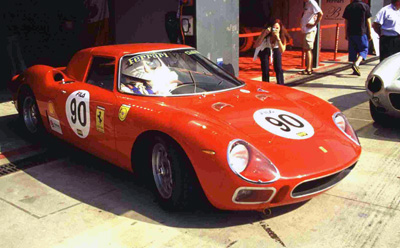 Ferrari 250LM (Fred Della Noce)
Ferrari 250LM (Fred Della Noce)
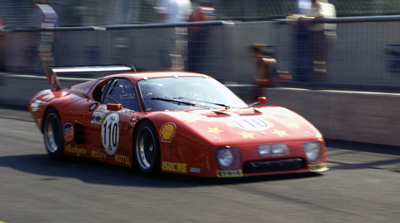 Ferrari 512BB LM (Jan Guikas)
Ferrari 512BB LM (Jan Guikas)
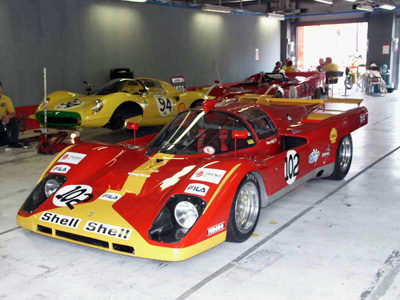 Ferrari 512M (Patrick Sieger)
Ferrari 512M (Patrick Sieger)
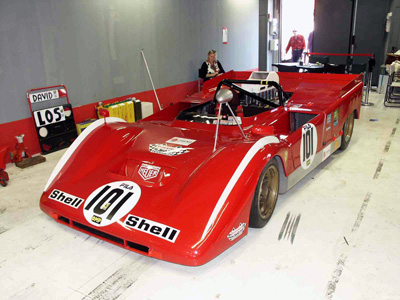 Ferrari 712 (David Franklin)
Ferrari 712 (David Franklin)
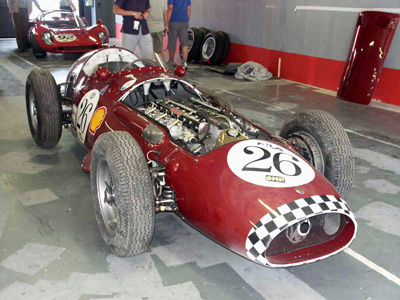 Maserati 250F (Burkhard Von Schenk)
Maserati 250F (Burkhard Von Schenk)
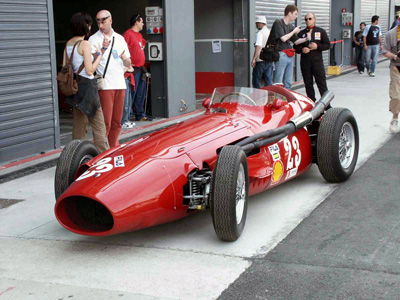 Maserati 250F (Thomas Bscher)
Maserati 250F (Thomas Bscher)
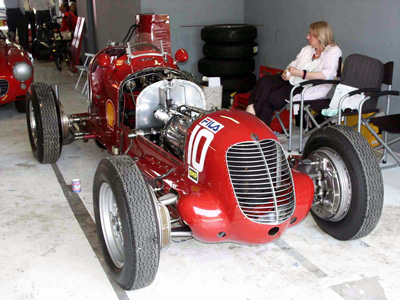 Maserati 6CM (Irvine Laidlaw)
Maserati 6CM (Irvine Laidlaw)
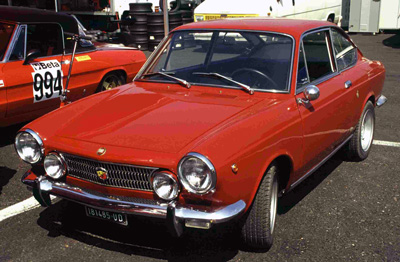 Abarth OT1300
Abarth OT1300
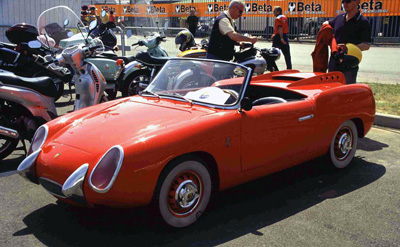 Abarth Zagato
Abarth Zagato



